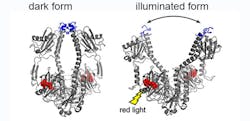Research team clarifies atom structure function of light-sensitive bio photosensors
Research groups at the University of Jyväskylä in Finland and the University of Gothenburg (Göteborg, Sweden) have clarified how the atom structure of bacterial red light photosensors changes when sensing light. The research reveals structural changes in phytochrome protein when illuminated, with potential for new breakthroughs in cell biology research and, for example, in medical applications such as phototherapy and in molecular diagnostics.
Related: New fluorescent protein makes internal organs visible, and does so noninvasively
“The results are a unique demonstration of proteins’ ability to structural changes in different phases of their operation. This helps to understand how the biological photosensors function. The modeling and utilization of protein for other applications becomes much easier when the protein structures, their changes, and the speed of change are known,” says Professor Janne Ihalainen, who led the University of Jyväskylä team.
Organisms use photosensor proteins to sense light on different wavelengths. For example, mammals have rhodopsin proteins in their eyes. Phytochromes, one of the photosensor proteins of plants, fungi and bacteria, are sensitive to red light. The function of these photosensors was known already in 1970s and 1980s, but their molecular-level operating mechanisms are still unknown.
Time-resolved wide-angle x-ray scattering (TR-WAXS) was used to study structural changes of this rather large protein complex in a solution form. TR-WAXS is relatively new; in the study, a successful combination of the experimental data with the molecular dynamic simulations enabled to track the detailed structural changes of the protein.
“We hope that other groups using TR-WAXS would test similar data analysis method as well,” Ihalainen says.
The light-sensitive phytochrome structures were clarified both in a crystal form and in a solution. From the crystal structures, it is possible to see that small movement of individual atoms (scale of 0.1–0.2 nm) caused by the absorption of light is amplified to large structural changes (3 nm) in the whole protein complex. This amplification mechanism enables the light-induced signal transmission from one protein to another very quickly and with precise replication accuracy. In turn, this signal transmission process initiates cellular-level changes in the organism.
Full details of the work appear in the journal Nature; for more information, please visit http://dx.doi.org/10.1038/nature13310.
-----
Don't miss Strategies in Biophotonics, a conference and exhibition dedicated to development and commercialization of bio-optics and biophotonics technologies!
Follow us on Twitter, 'like' us on Facebook, and join our group on LinkedIn
Subscribe now to BioOptics World magazine; it's free!


